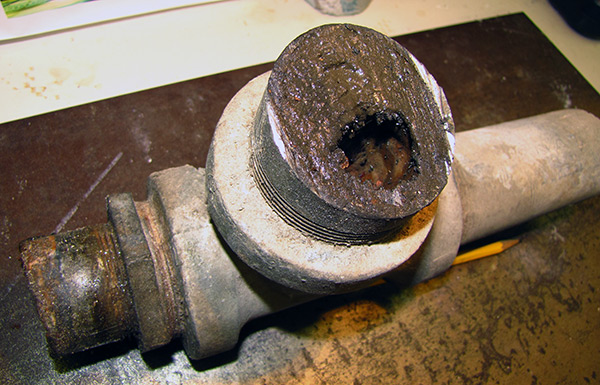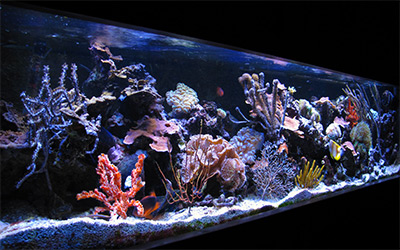Old Tank Syndrome, or OTS, is something we have been hearing about since the hobby started, and I am not quite sure exactly what it means. Is it due to parameters, loss of diversity, lack of interest, diseases, metal accumulation, global warming, locusts, or all of the above? I think it is much simpler than “all of the above,” but some of those things are probably on the list of causes—especially locusts.
It’s about bacteria
In my opinion, OTS has to do with bacteria, or lack of it. Bacteria really run our tanks, and we are just there so the bacteria have something to make fun of. Without bacteria, our tanks would crash in less than a day. Of course on the other side of the coin, bacteria are also the cause of tank crashes. Bacteria can work for us or against us, and even the same bacteria can work both ways.
Some bacteria can double in numbers in an hour (I wish my tomatoes would grow half as fast as bacteria!). Just put a dead fish in a container of water (preferably in your girlfriend’s or boyfriend’s house) and see how quickly it stinks. If you put a live, healthy fish in a container of water, nothing will happen—the water will remain clear, for a day or so anyway. What is the difference? How do the bacteria know that they should foul the water?
It is simple. The healthy fish has an immune system that prevents the bacteria from decomposing it. As soon as the fish dies, its immune system also dies and the bacteria hear a dinner bell and start consuming its body—not just the bacteria on the fish, but also the bacteria inside the fish, mostly in its gut, which is filled with bacteria.
Of course, if we leave the fish in that container of water for any length of time, bacteria will also kill it, but for a different reason. In this case, there are not enough bacteria in the water to convert the ammonia that the fish excretes through its gills into something less toxic, so the fish dies of ammonia poisoning. In a sense, it’s not the ammonia that kills the fish, but the lack of bacteria.
A matter of multiplication
Luckily for us (and our fish), bacteria usually “know” how many of them should multiply in a certain situation. For instance if we overfeed our tank, the bacteria will multiply very quickly, and because bacteria can’t really swim, or even dog paddle, all the available spaces on the rocks will be covered in bacteria, forcing the overpopulation into the water column where they cloud the water. (I assume they learn how to swim very fast, but I really don’t know.) In time, the bacteria will consume all the food and the tank will clear.
The problem with doing this is that most of those bacteria that are clouding the water also use oxygen, just like the fish, and they can easily use it all up, causing the fish to gulp air at the surface. The majority of fish were not designed to live like that, so unless they are lungfish, they can die.
Bacteria and OTS
What does all this have to do with OTS? As I said, we need bacteria and bacteria live on and “in” all the surfaces in the tank. Many of those spaces in a tank are inside the rocks. These are places we rarely think about, but they’re home to the types of bacteria we need to purify the water. Bacteria certainly live on the surfaces of the rock, but there is much more surface area inside the rock where the bacteria like to party. In time, those spaces, or pores, will clog. They will clog with detritus, which in boating terms we call “flotsam and jetsam.” That means just about anything that is a solid and in the water. It could be dead bacteria, pod exoskeletons, or anything else we have in the tank that eventually gets ground down by animals and currents.
Remember, at one time, eons ago, the sand was rocks, meteorites to be exact. Then storms, volcanoes, and lightning broke up the rocks, dinosaurs and Bigfoot walked on them, and, finally, SUVs finished the job. Eventually those rocks became sand, and that sand, even today, keeps getting smaller and smaller, sort of like my bank account.

In the sea, fish like parrotfish chew on the reef and excrete sand, but the stuff they are chewing on is not really rock, but coral rock, which was made by calcium-secreting creatures. Anyway, this also happens in our tanks to a smaller degree, and those tiny particles get trapped in the pores in the rock just like old plumbing pipes eventually get clogged. That leaves fewer places for the bacteria to live. Fewer bacteria equals less capacity to purify the water. This happens in tanks at the same time that the organic load is getting larger.
In older tanks, we have more fish and larger fish because we have gotten older, our boss has given us raises, and our kids have (hopefully) grown up and moved out, so we can go out and buy more fish. Do the bacteria care? Of course not. They can’t elevate their numbers because the pores in the rock are clogged, and besides bacteria being stupid, they are also lazy and won’t even try to clean out the pores in the rock. Instead, they will let the pollution build up in the tank in the hope that the fish will die so they can all feast on Thanksgiving dinner.
Typhoon time!
This does not happen in the sea for a very good reason. The sea has Mother Nature caring for her, and we have Old Aunt Ester. Mother Nature (or Al Gore) invented typhoons. Typhoons were a wonderful thing before she mistakenly invented humans who insist on building condos near the shore. In the sea, typhoons completely churn up the sand and everything on it. I have gone diving in places right after hurricanes and typhoons and have seen brain corals half the size of my house upside down. I have seen sea fans hundreds of yards up on mountainsides alongside yachts. These occurrences destroy some corals, but they also allow others to flourish. It’s like forest fires; they are needed to restore forests, kill insects, and keep insurance companies in business.
This undersea carnage helps to keep the pores in the rock open, and the wave action breaks open rocks to allow access to the virgin pores inside them. Those pores will quickly fill with bacteria that purify the water.
We can carry our tanks to an airport, get on a plane to a tropical destination just before a typhoon, and set them down on the sand to be stirred up, but the airlines frown on that. What you can do is take a canister filter (I use a diatom filter) and put a restriction on the output hose. I use one of those little plastic funnel-looking things that florists use to keep cut flowers fresh. But anything that restricts the water flow is good, and you can use that just like a power washer.
You will be amazed at how much gunk will come out of reef rock when you put this device right on the pores. Don’t hit the corals with this pressure unless you don’t want them. I do this twice a year on all the rocks that I can reach. In my setup, I also stir the gravel all the way down to the bottom of the tank, but if you have a deep sand bed, you should not do that (which is why I do not like DSBs). The more you can stir things up, the more gunk you get out, the more spaces for bacteria, and the longer your reef can last.
This is all just my opinion, of course, and you surely do not have to believe me. In a few years my reef will be 50 years old, and I believe it got to that age because of this procedure, which only takes me an hour or so twice a year. Of course at that time, I will be 120 years old, so I may take the tank down then and set it back up in my nursing home, where a retired supermodel will do this maintenance for me.



